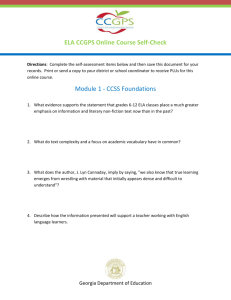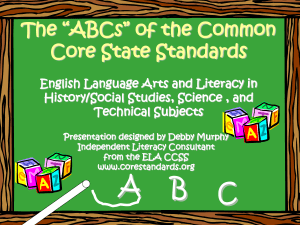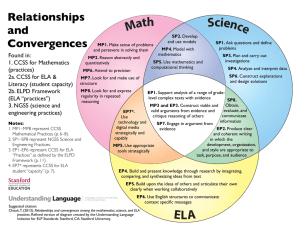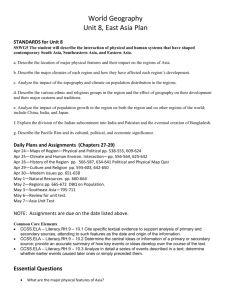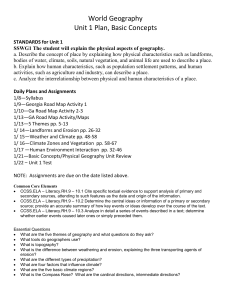What Supports Do Teachers Need to Help Students Meet Common
advertisement
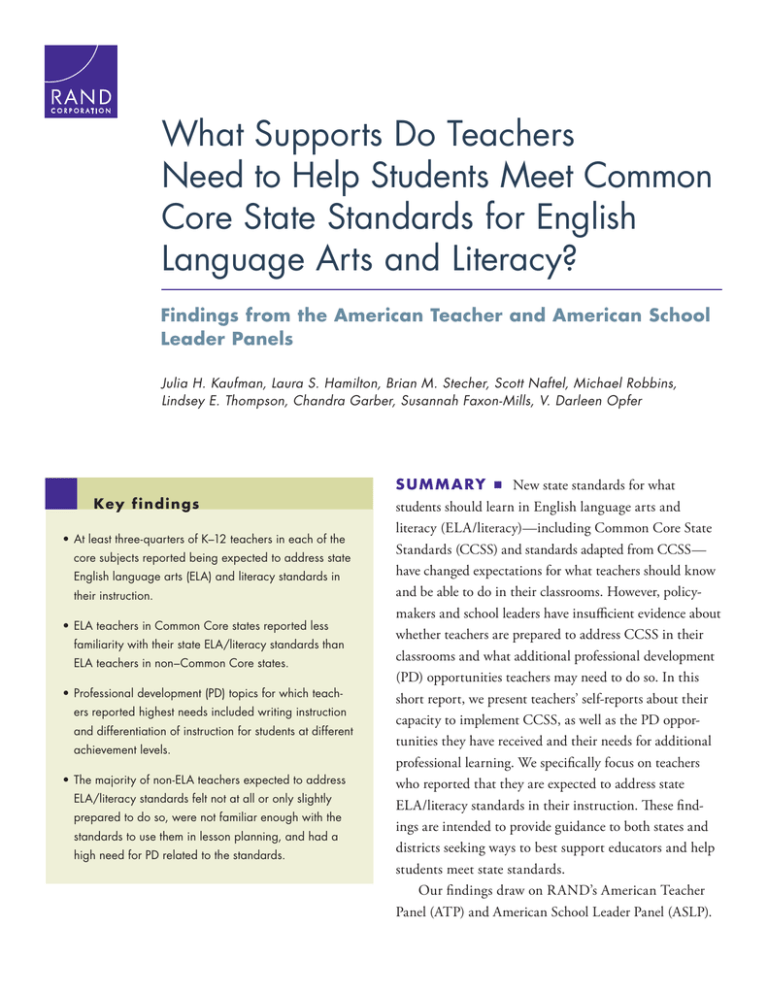
C O R P O R AT I O N What Supports Do Teachers Need to Help Students Meet Common Core State Standards for English Language Arts and Literacy? Findings from the American Teacher and American School Leader Panels Julia H. Kaufman, Laura S. Hamilton, Brian M. Stecher, Scott Naftel, Michael Robbins, Lindsey E. Thompson, Chandra Garber, Susannah Faxon-Mills, V. Darleen Opfer Ke y findin gs • At least three-quarters of K–12 teachers in each of the core subjects reported being expected to address state English language arts (ELA) and literacy standards in their instruction. • ELA teachers in Common Core states reported less familiarity with their state ELA/literacy standards than ELA teachers in non–Common Core states. • Professional development (PD) topics for which teachers reported highest needs included writing instruction and differentiation of instruction for students at different achievement levels. • The majority of non-ELA teachers expected to address ELA/literacy standards felt not at all or only slightly prepared to do so, were not familiar enough with the standards to use them in lesson planning, and had a high need for PD related to the standards. S U M M A RY ■ New state standards for what students should learn in English language arts and literacy (ELA/literacy)—including Common Core State Standards (CCSS) and standards adapted from CCSS— have changed expectations for what teachers should know and be able to do in their classrooms. However, policymakers and school leaders have insufficient evidence about whether teachers are prepared to address CCSS in their classrooms and what additional professional development (PD) opportunities teachers may need to do so. In this short report, we present teachers’ self-reports about their capacity to implement CCSS, as well as the PD opportunities they have received and their needs for additional professional learning. We specifically focus on teachers who reported that they are expected to address state ELA/literacy standards in their instruction. These findings are intended to provide guidance to both states and districts seeking ways to best support educators and help students meet state standards. Our findings draw on RAND’s American Teacher Panel (ATP) and American School Leader Panel (ASLP). 2 The ATP and ASLP take the pulse of the nation’s educators on key issues of education policy and practice through periodic surveys of a representative sample of teachers and principals across the United States.1 The results reported here are from the February 2015 survey of the ATP and ASLP.2 ATP and ASLP data and methods for sampling and weighting are described at the end of this report. While this report focuses on supports to help teachers address state ELA/literacy standards, our next report will consider supports to help teachers address state mathematics standards. In a previous report, we highlighted teacher and school leader concerns about state-mandated assessments.3 BAC KG RO U N D The CCSS for ELA/literacy embody higher expectations than most states’ previous standards. For example, CCSS include higher expectations for students to engage in close reading of complex texts,4 and teachers are to integrate literacy instruction with disciplinary content across school subjects.5 These higher standards change expectations for what teachers must know and be able to do, both within and beyond ELA classrooms. School leaders and teachers themselves have expressed concerns that they are not ready to help students meet new ELA/literacy standards.6 A Center on Education Policy report released last year indicated that about one-quarter of district administrators did not think that they would be able to adequately prepare all ELA teachers to teach the CCSS until the 2015–16 school year or later, and almost one-half of the administrators cited the lack of high-quality PD and support for teachers’ implementation of CCSS as major challenges.7 Additionally, while a 2013 survey indicated that more than three-quarters of teachers had received at least some training related to CCSS in ELA/literacy, only 11 percent of all teachers strongly agreed that their CCSS training had been of high quality.8 R ESU LTS At least three-quarters of K–12 teachers in each of the core subjects reported being expected to address state ELA/literacy standards in their instruction.9 Given that state ELA/literacy standards are applicable to teachers across subjects, it may be unsurprising that our survey respondents reported addressing state ELA/literacy standards to some degree or extensively in many subjects (Figure 1). Teachers of multiple subjects (e.g., elementary teachers in some schools) rated the extent to which they were expected to address ELA/literacy standards separately in each subject taught. Even in mathematics, at least three-quarters of all teachers reported that they are expected to address ELA/literacy standards at least to some degree. These findings suggest that most teachers could likely benefit from guidance and support on how to help students meet ELA/literacy standards. 3 Expected to address ELA/literacy standards to “some degree” 100 Expected to address ELA/literacy standards “extensively” 6 10 80 Percentage of teachers As noted in Figure 2, over 70 percent of ELA teachers in states that had not adopted CCSS reported being familiar enough with ELA/literacy standards in their states to develop lessons and assessments and to explain their state standards thoroughly to colleagues, compared to only 47 percent reporting the same level of familiarity in CCSS states.11 Teachers in non-CCSS states may have reported greater familiarity with their standards because they perceive that their state standards have not changed as much over the past several years as those in states that have adopted CCSS, although many non-CCSS states (e.g., Nebraska and Indiana) have adopted new or revised standards for ELA/literacy relatively recently. Non-ELA teachers in Figure 2 and subsequent figures include only teachers who reported that they were expected to address ELA/literacy standards in instruction. Compared to ELA teachers, lower percentages of non-ELA teachers reported being familiar with these standards. However, no significant differences in familiarity were observed between non-ELA teachers in states that had or had not adopted CCSS. Additionally, while about 48 percent of elementary teachers indicated being familiar enough with the standards to use them in the development of lessons and assessments and explain them to colleagues, only 21 percent of middle school teachers and 17 percent of high school teachers indicated the same level of familiarity. School principals were also asked to rate their familiarity with state ELA/literacy standards on a four-point scale (1 = unfamiliar or slightly familiar; 2 = general understanding without the details; 3 = familiar enough to discuss them with teachers but not support teachers’ use of them; 4 = familiar enough to discuss them with teachers and support teachers’ use of them). Just over 60 percent of principals in CCSS states indicated that they understood ELA/literacy standards well enough to discuss them with teachers and support teachers’ use of them. Another 28 percent indicated that they understood the standards at least well enough to discuss them with teachers. We did not observe any differences in familiarity with ELA/literacy standards between principals in CCSS states and non-CCSS states. Figure 1. Percentages of Teachers Expected to Address State ELA/Literacy Standards in Instruction 46 37 53 60 60 53 48 94 40 84 47 20 45 37 27 31 27 0 CCSS NonCCSS CCSS English language arts teachers NonCCSS CCSS Mathematics teachers1 NonCCSS Science teachers CCSS NonCCSS Social studies teachers 1 Differences in distribution of “extensively” responses between CCSS and non-CCSS mathematics teachers were statistically significant. Figure 2. Familiarity with ELA/Literacy Standards Among Teachers Expected to Address These Standards in Instruction 100 1 3 4 11 Unfamiliar or only slightly familiar with ELA/literacy standards 25 22 80 Percentage of teachers ELA teachers in CCSS states were less familiar with their state ELA/literacy standards than ELA teachers in non-CCSS states.10 31 General understanding without the details 40 Familiar enough to develop lessons and assessments 60 37 40 34 Familiar enough to develop lessons/ assessments and also explain standards thoroughly to colleagues 71 47 20 28 33 10 3 0 ELA1 Non-ELA CCSS States ELA Non-ELA Non-CCSS States 1 Differences in distribution of familiarity responses between CCSS and non-CCSS ELA teachers are statistically significant. NOTE: Numbers may not sum to 100 due to rounding. 4 Most ELA teachers reported being prepared to help students meet the standards, although significantly lower percentages of non-ELA teachers reported feeling as confident about their preparation. A large majority of ELA teachers felt moderately or well prepared to help students meet ELA/literacy standards; non-ELA teachers were less likely to be prepared than ELA teachers.12 Most ELA teachers reported being prepared to help students meet the standards, although significantly lower percentages of non-ELA teachers reported feeling as confident about their preparation. As with familiarity findings, higher percentages of elementary teachers reported feeling well prepared to help students meet standards (48 percent), compared to their counterparts in middle school (19 percent) and high school (22 percent). We did not observe significant differences between reports of teachers from CCSS states and those from states that had not adopted CCSS (See Figure 3.). Figure 3. Preparedness to Address ELA/ Literacy Standards Among Teachers Expected to Address These Standards in Instruction 100 <1 10 1 12 Not at all prepared 4 25 Slightly prepared Percentage of teachers 80 34 44 Moderately prepared 43 60 33 40 61 46 31 32 14 10 20 0 ELA Non-ELA CCSS States ELA Non-ELA Non-CCSS States Well prepared Principals were also asked to estimate the percentage of their teachers who have adequate knowledge and skills to help students meet ELA/literacy standards. On average, principals in CCSS states estimated that 87 percent of their ELA teachers—and 69 percent of their non-ELA teachers who address ELA/literacy standards in their instruction—had adequate knowledge and skills to help students meet ELA/ literacy standards. Principals in states that had not adopted CCSS provided similar estimates. CCSS teachers who were expected to address ELA/literacy standards reported needing PD focused on differentiation of instruction and on writing.13 The ATP survey asked teachers to reflect on the current focus of their PD and their additional PD needs using a broad definition of PD that included “workshops, training, coaching, Professional Learning Communities, self-study, and/or other activities that have supported your work.” (See Figure 4.) Such PD could take place within districts through coaching and workshops with instructional leaders, coaches, or master teachers but could also be supported at the state level or through various providers. Among teachers who address state ELA/literacy standards in instruction, the topics for which teachers most frequently indicated a moderate or high need for additional professional learning and support included • differentiation of instruction for students at different achievement levels and for students with disabilities and English language learners • writing about complex topics and writing arguments to support claims in analysis of substantive topics. Around one-third or fewer teachers also indicated some need for PD related to reading, including support to help students analyze text structure and use textual evidence to make 5 Figure 4. PD Needs and Current Focus of PD Among Teachers Expected to Address ELA/Literacy Standards in Instruction in Percentages Differentiation of instruction for students at different achievement levels 48 61 43 Differentiation of instruction for students with disabilities 44 Engaging students in writing about complex topics in your subject area 41 Helping students write arguments to support claims in analysis of substantive topics 41 Moderate/high teacher need for additional PD 46 Current moderate/major focus of teacher PD 42 Differentiation of instruction for English language learners 38 Development of classroom assessment 38 41 52 Instructional strategies for meeting the state ELA/literacy standards in ELA classes 37 Instructional strategies for meeting the state ELA/literacy standards in non-ELA classes 37 63 50 Use of student work examples to inform instruction and/or understand whether students are meeting standards 35 61 Helping students use a range of general academic and domain-specific words and phrases sufficient for college and career readiness 34 41 Use of assessment data to inform instruction and/or understand whether students are meeting standards 34 72 Analyzing the structure of texts, including how sentences, paragraphs, and larger portions of text relate to each other and the whole 33 38 Engage students in talk with one another to express and build on one another’s ideas 32 Helping students use textual evidence to make inferences or support conclusions drawn from texts 32 48 52 Providing texts of appropriate complexity for whole class to read together 31 43 31 Content of state ELA/literacy standards 62 Helping students participate in a range of conversations and collaborations with diverse partners 30 48 Building knowledge through content-rich nonfiction and informational texts 29 51 0 20 40 60 80 100 Percentage of teachers inferences or support conclusions. The top PD needs for ELA and non-ELA teachers were fairly similar. According to teacher reports, the topics that PD currently focuses on in their schools were not necessarily the topics for which they had the greatest need. For example, a relatively high percentage of teachers reported a moderate or major focus of their PD was the use of assessment data to inform instruction and the content of the ELA/literacy standards, whereas only about one-third or fewer of teachers reported a moderate or high need for additional professional learning and support on those topics. Teachers at different school levels within CCSS states (or “CCSS teachers”) reported somewhat different professional learning needs. Specifically, elementary teachers in CCSS states 6 expressed a significantly greater need for PD on some writing topics and on general strategies for meeting ELA/literacy standards than did CCSS high school teachers. In addition, CCSS teachers in schools serving larger percentages of students eligible for free-and-reduced-priced-lunch (FRL) also indicated a greater need for writing PD than teachers in schools with smaller FRL populations. Our data do not suggest teachers’ PD had focused less on writing in elementary and high FRL schools than in other schools. The greater teacher needs for writing PD in elementary schools and high FRL schools could highlight writing challenges specific to students in these types of schools. Interestingly, the percentages of non-ELA teachers in CCSS states expressing moderate or high need for some PD topics were significantly higher than—and sometimes double—those of non-ELA teachers in states that had not adopted CCSS. For example, 33 percent of non-ELA teachers in CCSS states expressed a moderate or high need for PD on “helping students write arguments to support claims in analysis of substantive topics” versus 14 percent of non-ELA teachers in states that have not adopted CCSS. Other PD for which CCSS non-ELA teachers’ reports of needs were 15 to 20 percentage points higher than those for their counterparts in states that have not adopted CCSS included “providing texts of appropriate complexity for the whole class to read together,” “focusing student work on reading and writing grounded in evidence from the text,” and “helping students use a range of academic and domain-specific words and phrases sufficient for college and career readiness.” These higher PD needs among non-ELA teachers in CCSS states suggest that teachers across subject areas may be recognizing both higher expectations for them to address standards and a need for them to gain more familiarity with what the standards require. I M PLI C ATI O N S FO R STATE A N D D ISTR I C T P O LI C YM AK E R S Our findings provide some potentially good news about teachers’ capacity to help students meet state ELA/literacy standards, but they also highlight that certain kinds of teachers may be less prepared and/or familiar with the standards than others: • Most ELA teachers reported feeling adequately prepared and familiar enough with their state ELA/literacy standards to take them into account when developing lessons and assessments. However, ELA teachers in CCSS states reported significantly less familiarity with the standards than did ELA teachers in states that have not adopted CCSS. • In both CCSS and non-CCSS states, the many non-ELA teachers who are expected to address ELA/literacy standards in instruction reported feeling much less prepared to do so and were much less familiar with these standards than ELA teachers. • High school teachers also indicated less familiarity and preparation to address ELA/literacy standards than did their elementary counterparts. While many teachers report adequate familiarity with ELA/literacy standards, they will likely need PD that goes beyond conveying general information about standards and begins to target more in-depth instructional needs related to standards. In fact, as teachers gain more familiarity with the ELA/literacy standards, their need for more-targeted PD may increase as they recognize more of what they do know about the standards and how to operationalize them in the classroom through specific instructional practices. Our findings related to teachers’ professional learning suggest that teachers are receiving at least some PD on standards-related topics but may need more targeted supports in other areas: CCSS teachers in schools serving larger percentages of students eligible for free-and-reduced-priced-lunch (FRL) also indicated a greater need for writing PD than teachers in schools with smaller FRL populations. 7 The percentages of non-ELA teachers in CCSS states expressing moderate or high need for some PD topics were significantly higher than—and sometimes double— those of non-ELA teachers in states that had not adopted CCSS. • Roughly one-third to one-half of teachers indicated a moderate or high need for PD on a range of topics. The topics for which teachers most often indicated a need were support for writing instruction and for differentiation of instruction for students at different achievement levels, students with disabilities, and English-language learners. • The need for teacher professional learning support on writing-related topics was also higher among non-ELA teachers in CCSS states than among their non-ELA counterparts in states that have not adopted CCSS, higher among elementary than among high school teachers, and higher among those in schools with larger FRL populations than among those in schools with fewer FRL students. Taken together, these findings imply that states and districts are working to increase teachers’ capacity to address state ELA/literacy standards. However, they may now want to target supports to areas for which teachers have the greatest needs (e.g., differentiation of instruction and writing) and to particular subgroups of teachers who may need more guidance. NonELA teachers, in particular, are clearly being asked to address ELA/literacy standards in instruction, and this expectation is well aligned with the intent of the ELA/literacy standards to address disciplinary literacy across content areas. However, these teachers are also far less likely to report being familiar with and prepared to address standards than ELA teachers and may need more support across districts and schools to address ELA/literacy standards in instruction. The relatively high reported teacher need for PD focused on differentiation relative to some of the other PD topics we asked about in our survey may particularly reflect the greater rigor of new state ELA/literacy standards compared to what came before. For example, the ELA/literacy standards encourage all students to read challenging, complex texts at or above their grade levels rather than texts based on students’ individual reading levels.14 Since many classrooms include students who read at different levels, such a shift requires teachers to provide more differentiated support and diverse instructional strategies to support students at multiple reading levels who are reading the same challenging text, rather than only rely on leveled reading materials to provide that differentiation (e.g., leveled readers that are written at a variety of reading levels). These survey results could imply that teachers need more PD to help them make such shifts. On a separate note, these data also suggest that any increase in teachers’ familiarity with standards may not be followed by a decline in the need for standards-related PD. For example, while elementary teachers reported more general familiarity with standards than did high school teachers, they also reported greater PD needs than did high school teachers in a number of areas. These results suggest that teachers’ PD needs might deepen as they learn more about the standards and the shift in instruction necessary to implement the standards. The implication of a need for more in-depth PD places demands on districts and support providers to go beyond daylong workshops and walkthroughs of key elements of the standards to more-intensive and more-collaborative PD opportunities that provide focused guidance on teachers’ instruction and use of specific curricula. Indeed, much research suggests that the most effective professional learning opportunities are moderately intensive, ongoing, and curriculum specific.15 The RAND ATP and ASLP offer credible, reliable ways to track and monitor educators’ perspectives on major education policies and changes in these perspectives over time. Our 8 next report will focus on capacity and needs for teachers who are expected to address state mathematics standards in their instruction. We intend the findings in these initial reports to represent a first look at U.S. teachers’ self-reported capacity and PD needs related to standards-aligned instruction, with the assumption that teachers’ capacity and needs may change over time as they integrate new standards into what they think and do in their classrooms. As states and districts better understand teachers’ changing needs for support, they can tailor that support accordingly so that teachers succeed in helping students meet ambitious and rigorous state standards. As states and districts better understand teachers’ changing needs for support, they can tailor that support accordingly so that teachers succeed in helping students meet ambitious and rigorous state standards. 9 Notes 1 RAND Corporation, The American Teacher Panel & The American School Leader Panel, webpage, undated. As of November 23, 2015: http://www.rand.org/education/projects/atp-aslp.html 8 EPE Research Center, Findings from a National Survey of Teacher Perspectives on the Common Core, Bethesda, Md., 2013. 9 Maximum margin of error is ±4.7 percentage points for teachers’ responses on the ATP and ±8.3 percentage points for school leaders’ responses on the ASLP. Teachers’ reports of expectations for addressing standards are in response to the survey question, “How much are you expected to address the English language arts & literacy standards in [each of] the subjects you teach?” 3 10 2 Julia H. Kaufman, Laura S. Hamilton, Brian M. Stecher, Scott Naftel, Michael Robbins, Chandra Garber, Cordaye Ogletree, Susannah Faxon-Mills, and V. Darleen Opfer, What Are Teachers’ and School Leaders’ Major Concerns About New K–12 State Tests? Findings from the American Teacher and American School Leader Panels, Santa Monica, Calif.: RAND Corporation, RR-1294-BMGF, 2015. As of December 3, 2015: http://www.rand.org/pubs/research_reports/RR1294.html 4 Sheila Brown and Lee Kappes, “Implementing the Common Core State Standards: A Primer on ‘Close Reading of Text,’” Washington, D.C.: Aspen Institute, October 2012; Elfrieda H. Hiebert and Heidi Anne E. Mesmer, “Upping the Ante of Text Complexity in the Common Core State Standards: Examining Potential Impact on Young Readers,” Educational Researcher, Vol. 42, No. 1, January– February 2013, pp. 44–51; Timothy Shanahan, “Letting the Text Take Center Stage: How the Common Core State Standards Will Transform English Language Arts Instruction,” American Educator, Vol. 37, No. 3, Fall 2013, pp. 4–11, 43. 5 Timothy Shanahan and Cynthia Shanahan, “What Is Disciplinary Literacy and Why Does It Matter?” Topics in Language Disorders, Vol. 32, No. 1, January–March 2012, pp. 7–18; Vassiliki ZygourisCoe, “Disciplinary Literacy and the Common Core State Standards,” Topics in Language Disorders, Vol. 32, No. 1, January–March 2012, pp. 35–50; and P. David Pearson, “Research Foundations for the Common Core State Standards in English Language Arts,” in Susan B. Neuman and Linda B. Gambrell, eds., Quality Reading Instruction in the Age of Common Core State Standards, 2013, pp. 237–262. For this report, teachers in “non-CCSS states” are those in states that had not adopted CCSS at the time of survey administration, which are Alaska, Indiana, Nebraska, Oklahoma, Virginia, and Texas. For more information, see http://www.corestandards.org/standards-in-your-state. 11 Teachers’ reports of their familiarity with standards are based on the survey question, “Which phrase best describes your familiarity with your state standards in English language arts & literacy for the subject(s) and grade(s) you teach?” 12 Teachers’ reports of their preparation to address standards are based on the survey question, “How prepared are you—in terms of your knowledge and skills—to help your students to meet the state English language arts & literacy standards for the grade level(s) you teach?” 13 Teachers’ reports of the current focus for their PD are drawn from two survey questions: “How much has your professional development focused on the following topics thus far this school year (2014–15, including summer 2014)?” and “How much has your professional development focused on the following topics related to English language arts & literacy thus far this school year (2014–15, including summer 2014)?” Teachers’ reports of their PD needs are drawn from two survey questions, “How much do you need additional professional development on the following topics to support your instruction?” and “How much do you need additional professional development on the following topics to support your English language arts & literacy instruction?” 14 15 6 Nancy Kober and Diane Stark Rentner, Year Two of Implementing the Common Core State Standards: States’ Progress and Challenges, Washington, D.C.: Center on Education Policy, 2012; Milbrey McLaughlin, Laura Glaab, and Isabel Hilliger Carrasco, Implementing Common Core State Standards in California: A Report from the Field, Stanford, Calif.: Policy Analysis for California Education, June 2014; Stephen Sawchuk, “Many Teachers Not Ready for the Common Core,” Education Digest: Essential Readings Condensed for Quick Review, Vol. 78, No. 2, October 2012, pp. 16–22. 7 Diane Stark Rentner and Nancy Kober, Common State Standards in 2014: Districts’ Perceptions, Progress and Challenges, Washington, D.C.: Center on Education Policy, 2014. Shanahan, 2013. See, for example, Richard Correnti, “An Empirical Investigation of Professional Development Effects on Literacy Instruction Using Daily Logs,” Educational Evaluation and Policy Analysis, Vol. 29, No. 4, December 2007, pp. 262–295; Richard Correnti and Brian Rowan, “Opening Up the Black Box: Literacy Instruction in Schools Participating in Three Comprehensive School Reform Programs,” American Educational Research Journal, Vol. 44, No. 2, June 2007, pp. 298–339; Michael S. Garet, Andrew C. Porter, Laura Desimone, Beatrice F. Birman, and Kwang Suk Yoon, “What Makes Professional Development Effective? Results from a National Sample of Teachers,” American Educational Research Journal, Vol. 38, No. 4, December 2001, pp. 915–945; Jonathan A. Supovitz and Herbert M. Turner, “The Effects of Professional Development on Science Teaching Practices and Classroom Culture,” Journal of Research in Science Teaching, Vol. 37, No. 9, November 2000, pp. 963–980. About This Report This short report presents summary data from Web-based surveys RAND Education administered to the American Teacher Panel (ATP) and American School Leader Panel (ASLP) in February 2015. At the time of the administration of the surveys featured in this report, the ATP was composed of approximately 1,129 teachers, and the ASLP was composed of approximately 557 school leaders. Respondents were paid an incentive of $25 for every 30 minutes of survey time. Data for this report were collected in one survey wave fielded in February 2015. To ensure representativeness, panel members were sampled randomly from across the nation. The teacher sample included all full-time public school teachers in grades K–12 in all subjects, including teachers of special education students and English language learners. The survey data were weighted to account for differential sampling and for nonresponse. Weights were based on a model for nonresponse that incorporates such characteristics as teacher subject; school level, region, and size; and rate of free-and-reduced-price-lunch eligibility. The data collection and analysis of the February survey responses were funded by the Bill and Melinda Gates Foundation, the National Education Association, and by philanthropic contributions from RAND supporters and income from operations. Panel members are asked to complete periodic surveys on key education policy issues in the United States. If you are interested in learning more about the ATP and ASLP and how you could take advantage of this resource, please contact us at atp-aslp@rand.org. Print and Electronic Distribution Rights This work is licensed under a Creative Commons Attribution 4.0 International License. All users of the publication are permitted to copy and redistribute the material in any medium or format and transform and build upon the material, including for any purpose (including commercial) without further permission or fees being required. For more information on this publication, visit www.rand.org/t/rr1374. American Teacher Panel & American School Leader Panel © Copyright 2016 RAND Corporation Library of Congress Cataloguing-in-Publication Data is available for this publication. The RAND Corporation is a nonprofit institution that helps improve policy and decisionmaking through research and analysis. RAND focuses on the issues that matter most, such as health, education, national security, international affairs, law and business, the environment, and more. As a nonpartisan organization, RAND operates independent of political and commercial pressures. We serve the public interest by helping lawmakers reach informed decisions on the nation’s pressing challenges. RAND’s publications do not necessarily reflect the opinions of its research clients and sponsors. R® is a registered trademark. www.rand.org EDUCAT I ON RR-1374
